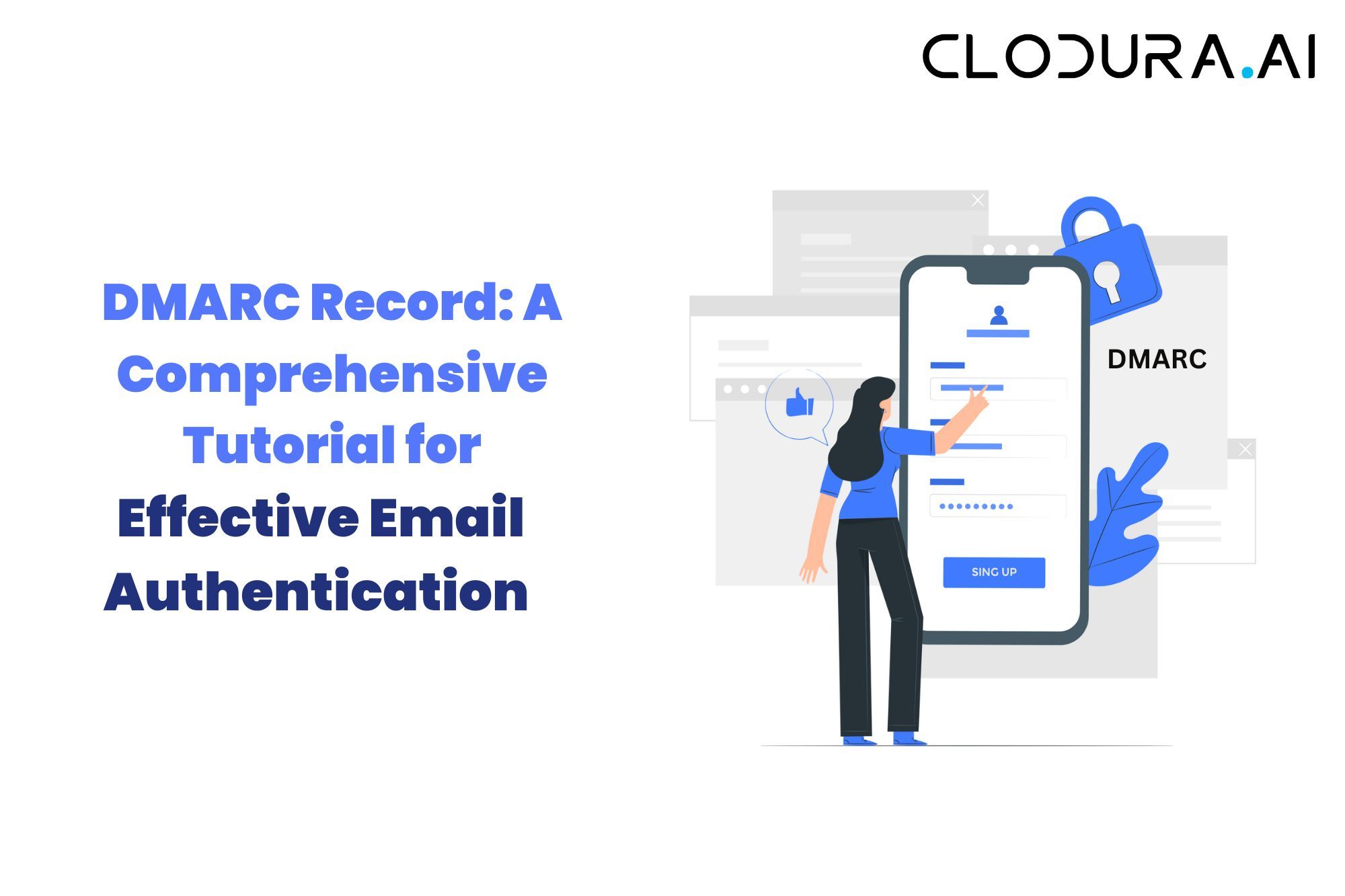Are you tired of dealing with spam emails and phishing attempts?
Looking for a way to protect your brand's reputation and secure your email communications? Look no further than the DMARC record. In this comprehensive tutorial, we will guide you through the process of implementing DMARC (Domain-based Message Authentication, Reporting, and Conformance) to effectively authenticate your emails and prevent unauthorized senders from impersonating your brand.
By understanding DMARC, you gain the power to verify the authenticity of emails sent from your domain and protect your recipients from receiving fraudulent emails. This tutorial will break down the complex concepts of DMARC into simple and actionable steps, making it easy for you to set up and configure a DMARC record that aligns with your email authentication goals.
With a properly configured DMARC record, you can take control of your email deliverability, increase brand trust, and significantly reduce the risk of your domain being used for malicious purposes.
So, let's dive in and unlock the power of DMARC to safeguard your brand's email communications.
What is DMARC and how does it work?
DMARC, which stands for Domain-based Message Authentication, Reporting, and Conformance, is an email authentication protocol that helps protect email senders and recipients from email spoofing, phishing attacks, and domain abuse. It functions by utilizing existing email authentication standards such as Sender Policy Framework (SPF) and DomainKeys Identified Mail (DKIM) to verify the authenticity of incoming emails.
DMARC is designed to provide senders with visibility and control over how their emails are handled by receivers. By specifying policies in the DMARC record, senders can instruct receivers on how to handle emails that fail the authentication checks. This allows organizations to proactively protect their brand reputation and the trust of their recipients.
When an email is sent, the recipient's email server checks the SPF and DKIM records to verify the sender's identity. SPF checks if the IP address of the sending server is authorized to send emails on behalf of the sender's domain. DKIM verifies the integrity of the email by checking the digital signature attached to it.
Once the SPF and DKIM checks are completed, the recipient's email server checks the DMARC record published by the sender's domain. The DMARC record contains instructions on how the receiver should handle emails that fail the authentication checks.
There are three possible DMARC policies that a sender can specify:
- None: The receiver will still accept and deliver the email, even if it fails the authentication checks. However, the receiver will send a report to the sender, providing information about the failed authentication.
- Quarantine: The receiver will treat the email as suspicious and may deliver it to the recipient's spam or junk folder. Again, a report will be sent to the sender.
- Reject: The receiver will reject the email and not deliver it to the recipient's inbox. A report will be sent to the sender.
By implementing DMARC, senders can gain insights into how their domain is being used for email communication. The reports generated by receivers provide valuable information about the sources of unauthorized email activity, allowing senders to take appropriate action to mitigate any potential threats.
Furthermore, DMARC helps prevent email spoofing by enabling domain owners to specify which email servers are authorized to send emails on behalf of their domain. This prevents cybercriminals from impersonating legitimate senders and deceiving recipients.
In summary, DMARC is a powerful email authentication protocol that enhances the security and trustworthiness of email communication. By leveraging existing authentication standards and providing senders with control over email handling, DMARC helps protect organizations from email-based threats and ensures the integrity of their brand.
Benefits of implementing DMARC for your email authentication
Implementing DMARC offers various benefits, both for the sender and the recipient. Firstly, it enhances email deliverability by reducing the chances of legitimate emails being marked as spam or rejected by recipient servers. This is achieved through the implementation of strict authentication protocols that verify the sender's identity and ensure that the email has not been tampered with during transit.
By implementing DMARC, senders can protect their domain reputation and brand integrity.
Cybercriminals often attempt to impersonate well-known brands through email spoofing, which can lead to financial loss and damage to the brand's reputation. DMARC helps prevent such impersonation by allowing senders to specify which servers are authorized to send emails on their behalf. This ensures that only legitimate emails from authorized sources are delivered to recipients, reducing the risk of brand impersonation and fraud.
From the recipient's perspective, DMARC provides an extra layer of assurance that incoming emails are legitimate and have not been tampered with. This is particularly important in today's digital landscape, where phishing attacks and email-based threats are becoming increasingly sophisticated. DMARC helps protect users from falling victim to these attacks by allowing email service providers to verify the authenticity of incoming emails and take appropriate actions if the emails fail authentication.
Furthermore, DMARC allows recipients to gain insights into the email traffic they receive. By implementing DMARC, organizations can receive detailed reports on the email sources and authentication results. This information can be used to identify any unauthorized senders or potential security vulnerabilities, allowing organizations to take proactive measures to mitigate risks and improve their email security posture.
Another benefit of DMARC is its compatibility with other email authentication protocols such as SPF (Sender Policy Framework) and DKIM (DomainKeys Identified Mail). DMARC builds upon these protocols, providing a comprehensive solution for email authentication. By implementing DMARC alongside SPF and DKIM, senders can maximize their email deliverability and ensure a higher level of trust and security for their recipients.
Overall, implementing DMARC for email authentication offers numerous benefits for both senders and recipients. It enhances email deliverability, protects domain reputation, safeguards against brand impersonation, and provides an extra layer of assurance for recipients. By leveraging DMARC alongside other authentication protocols, organizations can strengthen their email security and protect themselves and their users from email-based threats.
Setting up a DMARC record: Step-by-step guide
Setting up a DMARC record involves a series of steps to ensure proper configuration and effective email authentication. Let's walk through the process:
Step 1: Understand your email authentication setup
Before setting up DMARC, it is important to have a clear understanding of your current email authentication setup, including SPF (Sender Policy Framework) and DKIM (DomainKeys Identified Mail) configurations. SPF helps prevent email spoofing by specifying which IP addresses are authorized to send emails on behalf of your domain. DKIM adds a digital signature to your emails, allowing the recipient to verify the email's authenticity.
By understanding your existing email authentication setup, you can ensure a smooth integration with DMARC. This step will help you identify any gaps or misconfigurations that need to be addressed before proceeding.
Step 2: Create a DMARC record
Once you have a clear understanding of your email authentication setup, it's time to create a DMARC record. A DMARC record is a DNS TXT record that contains policies for your domain's email authentication.
The DMARC record specifies how email receivers should handle emails from your domain that fail SPF and DKIM checks. It allows you to set policies for email alignment, reporting, and actions to be taken when an email fails DMARC authentication.
Creating a DMARC record involves defining the following components:
|
By carefully configuring your DMARC record, you can ensure that email receivers handle your emails correctly and take appropriate actions based on your policies.
Step 3: Define policy actions
After creating the DMARC record, it's time to define the policy actions that email receivers should take when they receive an email that fails DMARC authentication.
Policy actions can include:
|
By defining clear policy actions, you can ensure that email receivers handle your emails according to your desired level of security and protection.
Step 4: Publish the DMARC record
Once you have defined the policy actions, it's time to publish the DMARC record by adding it to your domain's DNS settings.
Publishing the DMARC record allows email receivers to authenticate and handle your emails correctly based on the policies you have set. It is essential to ensure that the DMARC record is correctly configured in your DNS settings to avoid any disruptions to email delivery.
After publishing the DMARC record, it is recommended to monitor the DMARC reports received from email receivers. These reports will provide valuable insights into the authentication status of your emails and help you fine-tune your DMARC configuration if needed.
By following these step-by-step instructions, you can successfully set up a DMARC record for your domain, enhancing email authentication and protecting your brand's reputation against email spoofing and phishing attempts.
Troubleshooting common issues with DMARC implementation
Implementing DMARC can sometimes present challenges or encounter issues along the way. To help you navigate through potential roadblocks smoothly, we've compiled a list of common issues and their solutions:
|
By understanding these common pitfalls and their solutions, you can ensure a successful DMARC implementation and enjoy the full benefits of email authentication.
Monitoring and analyzing DMARC reports
DMARC provides robust reporting mechanisms that offer valuable insights into email authentication results. These reports, known as Aggregate (RUA) and Forensic (RUF) reports, provide detailed information on email delivery, authentication failures, and potential abuse attempts.
Regularly monitoring and analyzing these reports can help organizations identify and address any issues with their email authentication setup. This ensures ongoing effectiveness and helps maintain a high level of trust and security for email communication.
How to Monitor DMARC Performance
Monitoring the performance of your DMARC implementation is essential to ensure its effectiveness and make informed decisions for further enhancements. Here are some key metrics to monitor:
|
By regularly reviewing these metrics and analyzing trends, you can gain valuable insights into the impact of DMARC on your email deliverability and security posture.
Best Practices for DMARC Record Management
As with any technology, following best practices is crucial to maximize the benefits and ensure a robust email authentication setup. Here are some recommendations for effective DMARC record management:
|
By adhering to these best practices, you can ensure a strong and effective DMARC implementation, bolstering your email security and protecting your brand reputation.
Conclusion:
DMARC plays a vital role in email authentication and security. By understanding DMARC's inner workings, leveraging its benefits, and following best practices, organizations can enhance their email deliverability, protect their brand reputation, and provide a secure email environment for their users. Implementing DMARC is a proactive step to safeguard against cyber threats and ensure the integrity of your email communication.
FAQs
Q. Why is DMARC important for email authentication?
DMARC helps prevent email spoofing and phishing by providing a clear policy for handling unauthenticated email from your domain.
Q. How do I create a DMARC record?
To create a DMARC record, you need to define the policy for unauthenticated emails and publish it in your domain's DNS settings.
Q. What are the DMARC policy options?
DMARC policy options include "none" (monitor only), "quarantine" (move to spam), and "reject" (block unauthenticated email).
Q. Can DMARC be used alongside SPF and DKIM?
Yes, DMARC works alongside SPF and DKIM to provide comprehensive email authentication and protection against email fraud.
Q. How do I check if a domain has a DMARC record in place?
You can check if a domain has a DMARC record by using online DMARC lookup tools or by querying the domain's DNS for the presence of a DMARC TXT record.


